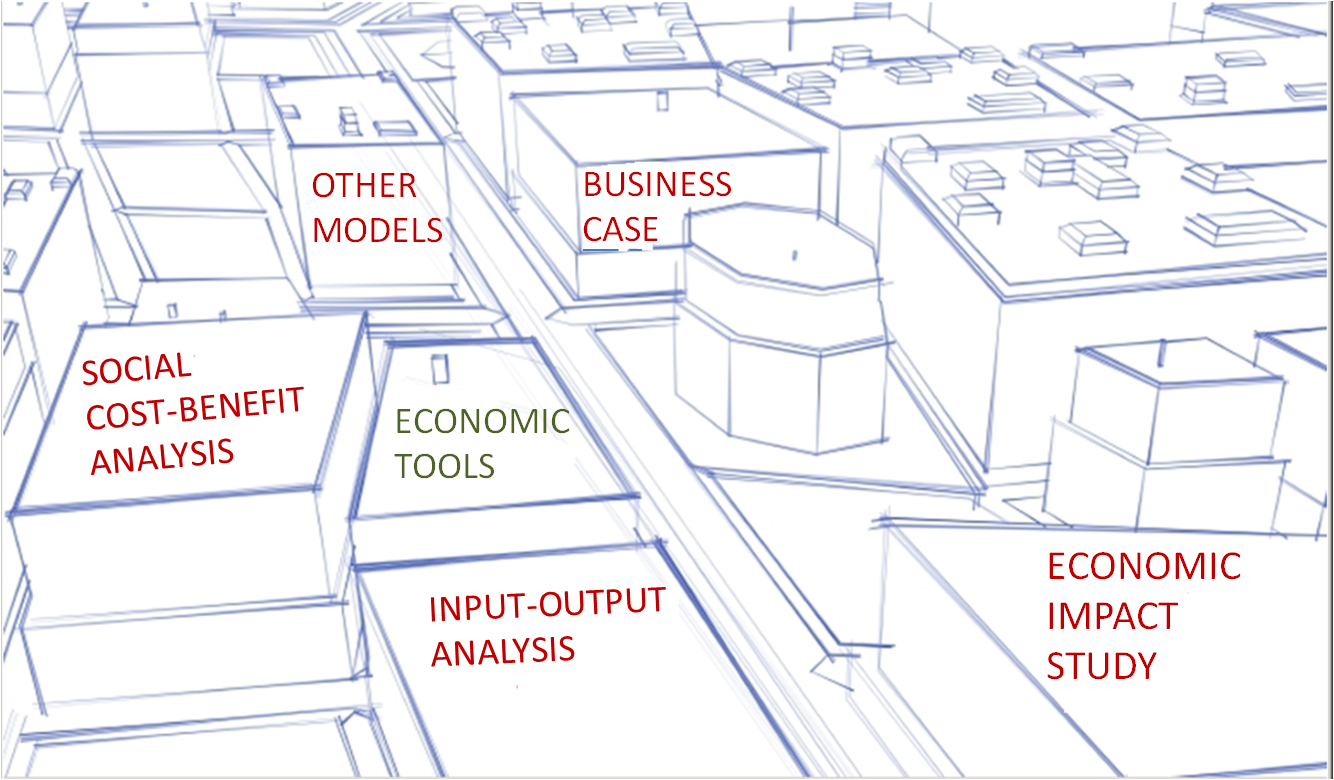Difference between revisions of "Economic tools"
| Line 7: | Line 7: | ||
Knowlegde about some frequently used economic models can help the urban planner to systematically survey all the relevant (socio-economic) impact caused by an urban development and security threats. This insight will help the responsible urban planners to make the best choices from an socio-economic point of view. |
Knowlegde about some frequently used economic models can help the urban planner to systematically survey all the relevant (socio-economic) impact caused by an urban development and security threats. This insight will help the responsible urban planners to make the best choices from an socio-economic point of view. |
||
It has to be noted that in general it is very difficult to quantify and monetarise the economic impact of urban development, urban objects, crime, security measures, and so on. This is especially true for the benefits (since they are in most of the cases non-economic, e.g., urban development as a catalyst for business investments, health benefits of less crime, the benefits of living in a safe area due to security measures, etc.). Moreover, while economic analysis is common in many contexts, the results of these studies depend largely on the used methodologies, including the underlying (subjective) assumptions and measured effects.<ref>For example: How does one economically quantify and monetarise the reputation of local police with regards to enforcing safety?</ref>. Nevertheless, it remains relevant for urban planners (especially on a more strategic level) to gain insight into the economic dimension of urban planning and security threats/measures. In the words of professors Ken Pease and Martin Gill<ref>Pease, K. and M. Gill (2011) Home security and place design: some evidence and its policy implications.</ref>, |
It has to be noted that in general it is very difficult to quantify and monetarise the economic impact of urban development, urban objects, crime, security measures, and so on. This is especially true for the benefits (since they are in most of the cases non-economic, e.g., urban development as a catalyst for business investments, health benefits of less crime, the benefits of living in a safe area due to security measures, etc.). Moreover, while economic analysis is common in many contexts, the results of these studies depend largely on the used methodologies, including the underlying (subjective) assumptions and measured effects.<ref>For example: How does one economically quantify and monetarise the reputation of local police with regards to enforcing safety?</ref>. Nevertheless, it remains relevant for urban planners (especially on a more strategic level) to gain insight into the economic dimension of urban planning and security threats/measures. In the words of professors Ken Pease and Martin Gill<ref>Pease, K. and M. Gill (2011) Home security and place design: some evidence and its policy implications.</ref>,"[economic]Cost benefit analysis is always helpful, sometimes necessary but seldom sufficient as a basis for decision-making". |
||
==Users of economic tools== |
==Users of economic tools== |
||
Revision as of 10:07, 7 December 2012
Contents
Economic tools
Economic tools (or tools of economic analysis) facilitate the preparation of a robust urban plan that encourages economic development in a way that is conducive to and compatible with sustainability objectives. Put differently, they influence the way planned urban objects and urban environments are going to be shaped. Furthermore, economic tools are applied to measure the economic impact of existing urban objects. In essence, they are urban planning tools (though not solely used by urban planners).
Relevance
Knowlegde about some frequently used economic models can help the urban planner to systematically survey all the relevant (socio-economic) impact caused by an urban development and security threats. This insight will help the responsible urban planners to make the best choices from an socio-economic point of view.
It has to be noted that in general it is very difficult to quantify and monetarise the economic impact of urban development, urban objects, crime, security measures, and so on. This is especially true for the benefits (since they are in most of the cases non-economic, e.g., urban development as a catalyst for business investments, health benefits of less crime, the benefits of living in a safe area due to security measures, etc.). Moreover, while economic analysis is common in many contexts, the results of these studies depend largely on the used methodologies, including the underlying (subjective) assumptions and measured effects.[1]. Nevertheless, it remains relevant for urban planners (especially on a more strategic level) to gain insight into the economic dimension of urban planning and security threats/measures. In the words of professors Ken Pease and Martin Gill[2],"[economic]Cost benefit analysis is always helpful, sometimes necessary but seldom sufficient as a basis for decision-making".
Users of economic tools
Economic tools can be used by economists (specialists) but also by specialized is an attribute of::urban planners in socio-economic appraisal.
Types of economic tools
Urban planning processes employ a host of economic tools/models:
- Social cost-benefit analysis
- Input-output analysis
- Economic impact study
- Business case
- Other economic tools
See also the clickable map below:
Related subjects
MAP
<websiteFrame> website=http://securipedia.eu/cool/index.php?wiki=securipedia.eu&concept=Economic_tools height=1023 width=100% border=0 scroll=auto align=middle </websiteFrame>
<headertabs/>

